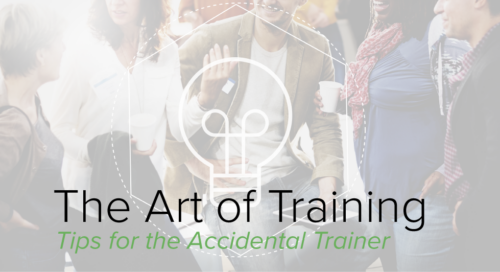The Art of Training: Tips for the Accidental Trainer
This post is from our newest featured blogger Shannon Tipton. She will also be presenting on this topic in an upcoming webinar.
Start with the Brain Not the PowerPoint
The brain is a wildly complex organ. John Medina the author of “Brain Rules” helps us to understand we still don’t understand the brain and how it works. “In truth, if we ever understood how the human brain knew how to pick up a glass of water, it would represent a major achievement.”
How can we use what we do know about the brain to help us create training courses, workshops, and resource materials that stick? Think about this: You grab a piece of paper and hold it up against a wall. You let it go and the paper flutters down to the ground. Why? Because it didn’t have an adhesive. It wasn’t a sticky note. It didn’t have tape. In essence, the paper didn’t have help. Think of information in the exact same way. Information entering the brain without an adhesive doesn’t stick. Okay, so how do we build this magical brain epoxy? Well, read on.
Types of Memory
Let’s make a comparison. The brain is like a giant walk in closet. Full of shelves, shoe racks, and hangers. Each one of those devices helps to organize our thoughts, allowing us to determine what we keep and what goes to the Goodwill. It’s important to understand that regardless of who you are, what you do, or how old you are…we all process information in exactly the same way. Where we differ is in the way we store the information in our closet and eventually in information retrieval. There is a pathway to how information enters the closet.
Sensory memory. This is the first stop shop for all information; consider it the doorway to the walk-in closet. Everything we do, see or experience first passes through this front door. “It’s raining outside”, “Gee, that pie smells good.”, “Hey! A $20 bill in my pants pocket!” all of this filters in…and mostly filters out. All processed with the same question: Do I need to put this piece of information in my closet? If so, we move to…
Short-term memory. We’ve decided that we want to keep some information for the short term, this means taking thought to action, “I’ve looked out the window and noticed, it’s raining outside.” Now, I’m going to store that thought away until I leave the house, and at that time I will grab an umbrella. Short-term memory items lead to an action. If it is just a short-term action (simply remembering to grab an umbrella) it’s then discarded after the action. Kicked to curb if you will. However, if…
Long-term memory. If this is information needs to stick around longer, further memory action will be required. So, it’s raining and you need your umbrella. However, you are going into the city and will have to carry it around with you all day. Your long-term memory remembers that you don’t want to take the GIANT umbrella, you need the little one that folds up and fits into your computer bag. Your long-term memory has connected “raining, umbrella and city” and then comes up with, “YO! Take the smaller one!”
Why is understanding the memory important?
Getting information from your short-term memory unto a rack in your walk in closet requires relevance. Thoughts that are random and unconnected do not stick in your mind. They get lost in the shoe pile on the floor. Let’s put this into real-life training terms:
Picture this: New Hire Orientation session. The trainer is telling the participants about the history of the company and the vision/mission statements. The participants are then expected to remember the information for a test at the end of the day. In order to “help” we give them a piece of paper to capture the notes. The trainer moves on to talk about how to clock in for the shift in every day.
When tested, the trainers are surprised the group cannot remember the key points of the company history and the vision/mission statements. Despite showing 10 slides and being told to take notes. We shouldn’t be. Telling people to take notes does not move the information from the short-term to the long-term memory. The pieces of information are not connected, nor are they relevant to the participants. Okay, so how do we make it relevant?
Create a connection. (As an aside, can we stop putting this type of mundane information on a PowerPoint slide, please?)
“Once upon a time, in a land far, far away…called Miami, there lived a single mom.” (Okay, I’m listening.)
“Like the little old lady who lived in a shoe, she had some little ones – who had the annoying habit of growing.” (Funny.)
“She lived in a neighborhood with other families in the same situation, kids that kept growing.” (I’m interested.)
“She got together with the other parents and they combined the kid’s outgrown clothes. They created a clothes swap.” (Ah, ha. I see where this is going.)
“This simple neighborhood need turned into the multi-billion dollar industry of *clothesswap.com” (Bingo, history told and not one boring date mentioned.)
“The need was simple, no parent should have to go broke providing clothing for their children.” (Mission/Vision)
Now, you’ve created a connection. Why? Not just because it’s a story, because it’s a story with a purpose. This purpose is worth remembering. We’ve created an empathetic memory where the odds of it being stored in our walk-in closet on the “work” rack is greater.
Brain Connections Using Context – Not PowerPoint.
If you want training to stick then train what people need to know to do the job. No more, no less. The best way to make training sticky is to add the adhesive called “So, what?” People take in information every second of every minute, of every day. The brain analyzes this information, gives a collective shrug and asks…”Yeah? So, what?” If we cannot connect the answer to this question, the brain will allow this information to flutter to the floor. When we don’t connect the dots the training fails.
Knowing this, creating in-context training becomes even more critical. The knowledge becomes part of the “work” rack in your walk-in closet. You may even have multiple “work” racks. One for, “how to process complaints”. One for, “how I use my work computer”. One for, “How I turn the widget without burning down the joint”. Each piece of relevant, supporting information goes on a hanger that then – you guessed it, hangs on the rack.
As an example, when training people how to use software – have the hardware and software available. I know this is obvious, but often times I hear stories of how people participating in technology training have to share computers. One cannot possibly complete a puzzle when puzzle pieces are missing.
Person A practices steps 1 – 5
Person B practices steps 6 – 10
Both people have incomplete connections. Don’t be surprised when you get calls needing help. To this point, we need to build a sturdier closet rack and create job aids that show the participants exactly (no more, no less) how to do the job. Have the participants teach themselves the software using the resources. This, my training peeps, is in-context training. Want people to use the resource? Train the resource. Teach the brain to understand the resource. Giving the resource its own hanger on the “work” rack.
So, now what?
People are inundated with information. All the time. How can you best help put the information you need them to have, in a context that will help connect the dots? Has the appropriate adhesive been supplied? The participant needs to leave the training session and be able to do the job better than when they arrived. Has the presented training help them do so? Are brain connections created? As John Medina says, “If you are in education, you are in the business of brain development”. #LetsDoThis
Read this!
There is so much more to learn about the brain and about how people learn. I highly suggest the following:
Julie Dirksen – Design for How People Learn. A wonderfully written book. This hits the nail on the head on how we should be thinking about the process of developing training that truly connects.
John Medina – Brain Rules. Love this book! Written in a way most regular people can grasp. Funny and compelling. Check out his Youtube video’s here.
Peter C. Brown, Henry Roediger, Mark MacDaniel – Make it Stick. These authors challenge some of the conventional thinking around traditional learning. In a spirited and engaging way.
(*Clothesswap.com is totally fictional, but not a bad idea)
Upcoming follow-up webinar
In an upcoming webinar, we will be discussing how all of this connects to information overload and how to avoid it. Look forward to seeing you all there.






